Let’s get right into it. What do you think of this patch?

Pretty nice, right? Thick, tight stitching, great color contrast and layering, clean text, and appealing directional stitching on the bell. If you submitted this design and received this patch, I’m sure you’d be satisfied.
But what if . . .
[Keep scrolling; I’m creating suspense.]What if you received this patch?

Wow! Why does that patch look so different—so much better?
One word: size. The patch in the first example is four inches overall. The bottom patch is 9.5 inches overall.
Larger patches simply look better. Why is this? For one thing, embroidery is radically different from pencil and ink, and even more radically different from computer graphics. Embroidery has one key limitation—thickness of the threads being used.
This concept carries over to all forms of physical art. Think of an artist creating a pencil sketch. What does he do if finer detail is required? He sharpens his pencil, thus making the tip smaller so he can achieve more detail. Perhaps he even has a case full of pencils, each with different tip thicknesses. What if a painter is in a similar situation, working on a very small section of her canvas? She’ll switch to a smaller brush.
When it comes to embroidery, threads are a set thickness. Yes, there are different deniers of thickness available; however, a thread can only be made so small before durability is compromised. If we go back to our illustration of a painter, imagine she needed to paint a zebra that had to be detailed and accurate down to the smallest stripe. Now, imagine she had only one, moderately sized brush. Using that one brush, do you think her zebra would look best if she were to paint it on a canvas of two square-inches or six square-inches? I’m sure you understand the concept.
Here are a few more examples to help you get a better idea.
A small disclaimer so as not to confuse you: Regardless of the real life size of the patches depicted, I’ve made all the images similar in size in order for you to clearly see their detail.
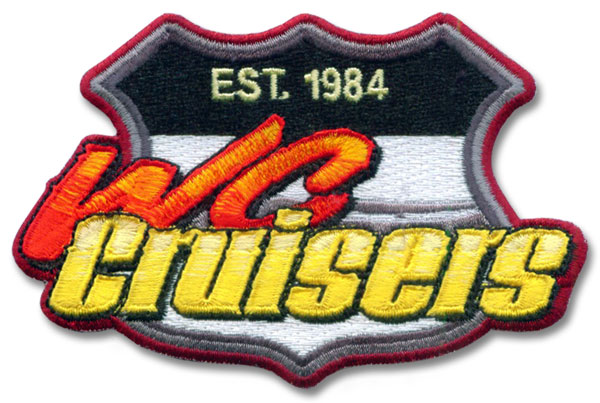
Looks great, doesn’t it? The patch is cut to shape very nicely with a triple border; all lettering is clear and clean. Even a blending of colors was expertly achieved in the lettering. “This patch couldn’t possibly look any better,” you may say.
Think again!
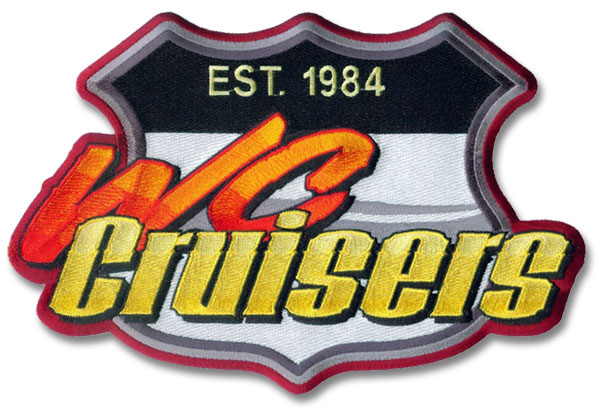
Ah, beautiful. Look at the blending in those letters now. Note how much better the “EST 1984” looks, even though it looked awesome before. Contrast the grays in the background and the borders. Amazing, isn’t it?
Here’s another one.
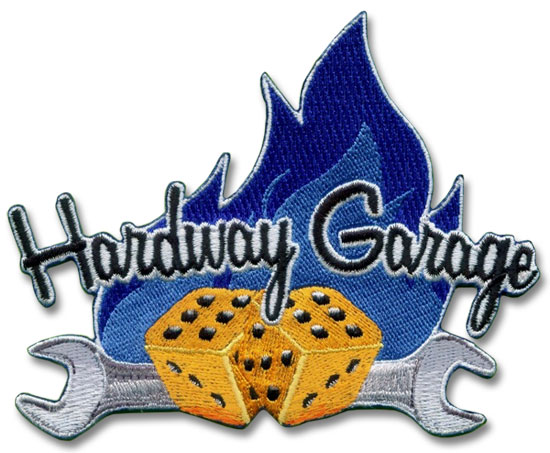
What a nice-looking diecut, 100% embroidered patch we made for Hardway Garage. Our customers don’t always tell us how their patches are going to be used, but we can only assume these 4.5 inch patches will be sewn onto the front of the mechanics’ uniforms. And don’t they look good?
We can also assume this same garage wanted to have patches for the backs of their mechanics’ uniforms as well—perhaps so that from afar, everyone would be able to easily recognize which individuals were the actual mechanics. What would this same design look like as a back patch, say at 13 inches or so?
BAM!
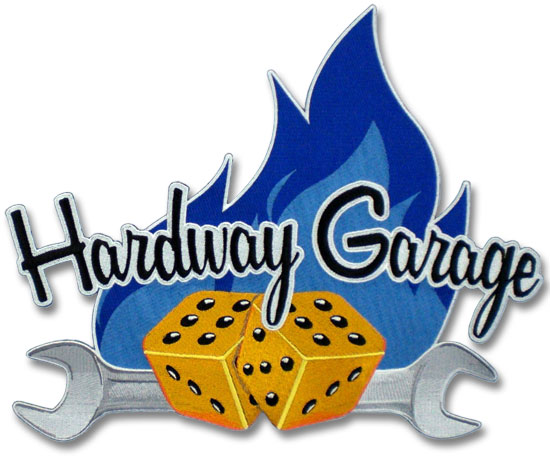
Wow! This patch is so crystal clear, that you almost can’t even see the stitching!
A quick note: Many people prefer to be able to clearly see the stitching on a patch and may actually tell you they prefer the look of the smaller example. When you increase patch size, at what point does the look of embroidery start to fade? In short, it all depends on the complexity of the design, as well as how many large areas of solid color exist. At the time of your order, you can ask your knowledgeable and well-trained account executive for advice and recommendations about your particular design.
Now, let’s do a familiar design—the American Flag.
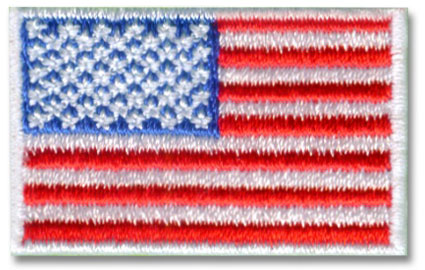
Not spectacular—we admit it. But this patch is a mere 1.5 x 1 inches.

Getting better at 2 x 1.5 inches . . .
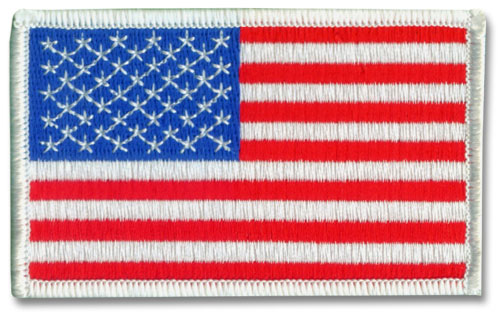
Now that’s what I’m talking about. At 3.5 x 2.25 inches, this looks perfect, no?

At 5 x 3, it’s still better. If the differences aren’t readily apparent to you, I’ll help you out. The most obvious difference is the stars, which I think is now self-explanatory if you look at both sets. But also look at the stripes. In the 3.5 x 2.25” example, you can clearly see the stitching, especially in the white. But in this example, all stitching is perfectly clean and tight. Once again, size makes all the difference.
Here are a few more examples for your viewing pleasure.
You may notice the following example has variations in text; however, the difference in the clarity of the text can still be easily discerned. Pay particular attention to the center design.
Not too shabby. Although only four inches, it’s still quite easy to discern exactly what is going on in this patch.
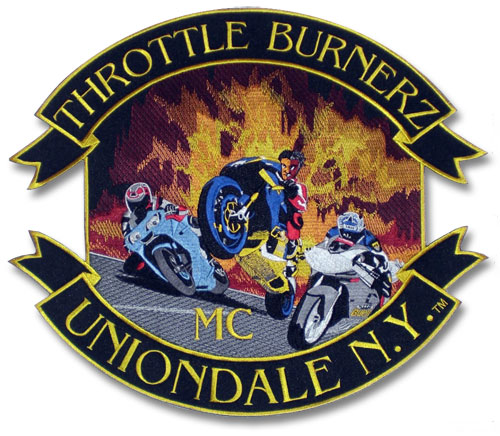
It gets better, though. In this twelve inch patch, the flames look more like flames; the bikes have greater detail; and you can make out not only the center guy’s face, but his expression as well.

How about the difference between twelve inches and 17.5 inches? The least subtle differences are the flames and the road. If you have a longer attention span than I do, you’ll find many more subtle differences between the two.
The previous example naturally begs the question: Do embroidered patches ever reach the point where increasing the size yields very little improvement? The answer is yes! Once a patch has reached it’s full potential—when all detail is as big as or bigger than a thread itself—increasing the size will no longer have an effect. OK, that may not be 100% true. It will have the effect of inciting someone to say, “Holy cow! That’s the biggest patch I’ve ever seen!”
If you’ve come this far, you must have an intensive interest in learning about embroidered patches, so I’ll give you a few more things to look at.




If you have a good eye for detail, you may be asking yourself the following two questions:
1) Why are the border sizes on some of the examples larger on the smaller patches?
2) Why have you mostly been showing biker patches and why are all your examples huge size jumps? Don’t you have any examples that show variations of only a couple of inches?
First off, when you see major differences in border sizes when the patch sizes are different, this means the borders are merrowed. Merrowed borders are always 1/8”. Something 1/8” will appear larger on a small patch and smaller on a large patch.
I have been mostly showing biker patches with dramatic size variations for two reasons:
1) Bikers order different size variations more than any other type of patch customer.
2) Bikers’ size variations tend to be significant, as they often order large patches for the backs of their jackets or vests, as well as small patches of the same design for the fronts of these jackets and vests.
So, is there a noticeable difference in quality when patches are two or perhaps only one inch apart? Certainly. Here are a few examples.



What do we take away from all this?
While Stadri has a special knack for fitting tremendous amounts of detail into small spaces, due to physical limitations of thread, larger sizes look better. That’s not to say we’re encouraging you to order twelve inch patches—for most organizations, these are completely unnecessary and excessive. Not to mention you can get fabulous looking patches at smaller sizes, which we’ve shown here. However, if you find your design to be rich in detail, increasing the overall size by one inch or even half an inch can sometimes make all the difference. You’re not left alone to make this decision. Our dedicated Account Executives and in-house Art Department will guide you through the entire process.
Armed with your newfound confidence, are you ready to design your own patch?
Already have your patch designed? Great! Get a quote now!




